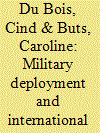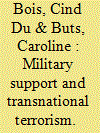| Srl | Item |
| 1 |
ID:
188410


|
|
|
|
|
| Summary/Abstract |
For decades, the concept of deterrence and the fear for nuclear confrontation withheld large powers from waging aggression against each other. Recent technological developments and the growing interconnectedness however allowed some states to find ways to challenge the West by using so called ‘hybrid threats’. This way of waging war entails the synchronized use of a broad spectrum of instruments that are well-designed to stay below the thresholds of detection, attribution and retaliation. Combining these (relatively cheap) threats with conventional military hard power confronts the liberal democracies with a difficult choice in terms of defence budget allocation. Whereas arms race stability in the conventional and nuclear domain leads to a peaceful stalemate, this article demonstrates that adding hybrid threats to the spectrum of state power projection leads to a gradual shift of the power balance. While hybrid threats have been extensively studied within the international relations literature, we are (to the best of our knowledge) the first to study these changing security paradigms from a defence economic point of view. Moreover, this article is the first to represent this increasingly complicated state power competition in a game theoretic framework.
|
|
|
|
|
|
|
|
|
|
|
|
|
|
|
|
| 2 |
ID:
155836


|
|
|
|
|
| Summary/Abstract |
Extant literature documents a relationship between military deployment and the risk of an international terrorist attack against citizens of the deploying country. It appears that deployment significantly increases the possibility of terrorist actions in the home country. In particular, if country A decides to send troops to nation B, then citizens of the former country are more likely to fall victim of an attack carried out by a terrorist organisation originating from the latter country. Contributing to this line of literature, we further refine this relationship by distinguishing between regions where the troops are sent as well as by introducing differences between types of deployment. Our results indicate that missions to Asia and the Middle East are more dangerous than missions to other regions as reflected by the terrorist threat in the home country. Robustness tests do however show that the significance of the location variable Asia is predominantly attributed to the mission to Afghanistan. As for types of deployment, only ad hoc missions seem to increase the risk of an attack, whereas no significant results are found for other missions such as operations under UN and NATO flag. Leaving out the missions to Iraq and Afghanistan however also increases the danger resulting from missions by fixed coalitions. Our results find however no evidence that ‘wearing a blue helmet’ increases the probability of a terrorist attack at home.
|
|
|
|
|
|
|
|
|
|
|
|
|
|
|
|
| 3 |
ID:
146504


|
|
|
|
|
| Summary/Abstract |
Analysing the relationship between the provision of military support and the probability of becoming the target of a terrorist attack, this paper contributes to the literature on the causes of transnational terrorism. We find that deployment of military troops of country X in country Y increases the probability of a terrorist attack on citizens of country X by a terrorist group located in country Y. Exporting weapons to country Y seems to increase the probability of being attacked by the terrorists of this country Y as well. Deploying materials, however, does not seem to significantly influence the probability of attack. Including lagged values for our military support variables ensures that the causality direction is from military support to terrorist attacks. Moreover, these results indicate that while the effect of military deployment on the probability of attack lasts for more than 1 year, the effect is rather short-lived.
|
|
|
|
|
|
|
|
|
|
|
|
|
|
|
|